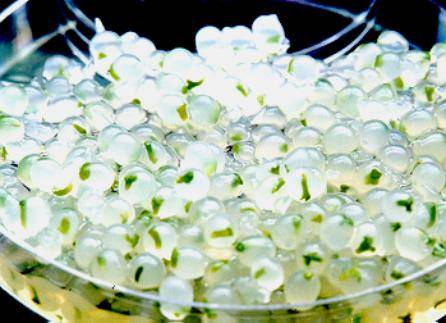https://www.ncbi.nlm.nih.gov/pmc/articles/PMC3550375/
The full .pdf can be downloaded.
This belongs here. Now we know how.
Image presented for visual of concept only.

dank.Frank
The full .pdf can be downloaded.
Abstract:
Axillary buds of Cannabis sativa isolated from aseptic multiple shoot cultures were successfully encapsulated in calcium alginate beads. The best gel complexation was achieved using 5 % sodium alginate with 50 mM CaCl2.2H2O. Regrowth and conversion after encapsulation was evaluated both under in vitro and in vivo conditions on different planting substrates. The addition of antimicrobial substance — Plant Preservative Mixture (PPM) had a positive effect on overall plantlet development. Encapsulated explants exhibited the best regrowth and conversion frequency on Murashige and Skoog medium supplemented with thidiazuron (TDZ 0.5 μM) and PPM (0.075 %) under in vitro conditions. Under in vivo conditions, 100% conversion of encapsulated explants was obtained on 1:1 potting mix- fertilome with coco natural growth medium, moistened with full strength MS medium without TDZ, supplemented with 3 % sucrose and 0.5 % PPM.
Encapsulation Matrix:
Sodium alginate was added in the range of 2-6 % (w/v) to full strength Murashigeand Skoog’s medium (MS) with or without 3 % sucrose. The solutions were supplemented with 0.5 μM Thidiazuron (TDZ) and 2.5 μM indole-3-butyric acid(IBA). A broad spectrum fungicide, Plant preservative mixture (PPM) in a range of 0.3-0.5 % was added to the gel matrix for in vivo experiments. For complexation, different concentrations (25-100 mM) of complexing agent (CaCl2.2H2O) were prepared in liquid MS medium containing the same adjuvents as the sodium alginate matrix but excluding the PPM. Both the solutions were autoclaved separately for 15 min at a pressure of 1.1 kg cm-2 and temperature of 121 ºC after adjusting the pH to 5.8.
Formation of beads:
The beads were formed by dropping explants mixed with sodium alginate solution into CaCl2.2H2O in a flask, placed on an orbital shaker at 80 rpm. The resulting beads (0.5-0.8 cm in diameter) containing the entrapped nodal segments were left in the calcium chloride solution for 30 min for complexation. These were retrieved using a nylon mesh and the traces of calcium chloride was removed by washing with sterilized distilled water.
This belongs here. Now we know how.

Image presented for visual of concept only.

dank.Frank
Last edited:



